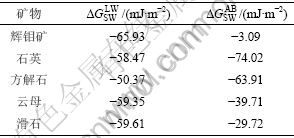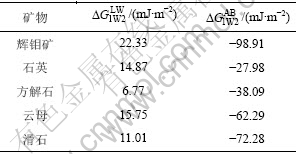辉钼矿浮选体系中的界面热力学
王 晖,陈 立,符剑刚,郝 野
(中南大学 化学化工学院,湖南 长沙,410083)
摘 要:通过辉钼矿浮选体系中矿物与水、捕收剂与水、矿物与气泡、矿物与捕收剂之间等一系列界面相互作用自由能的计算,对各界面之间的范德华力、疏水引力、水化斥力等界面热力学行为进行了研究。研究结果表明:各矿物表面与水之间均存在范德华引力和疏水引力,其中辉钼矿与水之间的疏水引力低于脉石矿物与水之间的疏水引力;捕收剂与水分子之间的疏水引力是导致捕收剂在水溶液中分散的主要作用力;辉钼矿与气泡之间的强疏水引力是辉钼矿具备天然可浮性的根本原因;水介质中辉钼矿与捕收剂之间的范德华力为引力,但范德华力不是辉钼矿与捕收剂之间的主要作用力,起捕收作用的主要因素是由Lewis acid-base(AB)相互作用造成的疏水引力。浮选实验结果表明:对于辉钼矿的浮选,捕收剂在矿物表面的吸附强度并不是影响其浮选指标的决定性因素,而捕收剂在水相中的分散能力以及捕收剂对矿物浮选的选择性对矿物浮选的影响较大。
关键词:辉钼矿;浮选;界面热力学;接触角;表面能
中图分类号:O647.11 文献标识码:A 文章编号:1672-7207(2007)05-0893-07
Interface thermodynamics of molybdenite floatation system
WANG Hui, CHEN Li, FU Jian-gang, HAO Ye
(School of Chemistry and Chemical Engineering, Central South University, Changsha 410083, China)
Abstract: The interface thermodynamics involving Van der Waals force, hydrophobic attractive force and hydration exclusive force were investigated by calculating the interfacial interactive free energy of a series of interfaces such as minerals and water, collectors and water, minerals and bubble, minerals and collectors in the molybdenite floatation system. The results show that Van der Waals attractive force and hydrophobic attractive force exist in each minerals and water interface, the hydrophobic attractive force in molybdenite and water interface is remarkably weaker than that in gangue and water interface. The hydrophobic attractive force between molecule of collectors and water is the main force which causes the collectors to disperse in pulp. The strong hydrophobic attractive force between molybdenite and bubble interface is the basic reason which causes the natural flotability of molybdenite. In water solution, the Van der Waals force between molybdenite and collectors is attractive, but it is not the main force between them, the main factor resulting in collection is hydrophobic attractive force caused by the Lewis acid-base interaction. In molybdenite floatation system, the floatation experimental results show that the adsorption intension of collector on molybdenite surface is not the crucial factor, while the dispersing capability of collector in water phase and its selectivity for minerals floatation are more important.
Key words: molybdenite; flotation; interface thermodynamics; contact angle; surface free energy
表面自由能是指在液体或固体的表面,其分子受到不平衡的分子间力的影响而产生的附加的能量[1-2]。进行界面热力学研究的有力工具是扩展的DLVO理 论[3-7]。该理论认为,如果不考虑静电相互作用,两物质(组分)之间相互作用总的自由能(?GTot)应包括Lifshitz-Van der Waals相互作用自由能(?GLW)以及Van Oss-Chaudhury-Good界面极性相互作用自由能(?GAB)[8-10],包括范德华力、疏水引力或水化斥力。其中:?GLW与物质表面能Lifshitz-Van der Waals分量(色散分量)有关;?GAB则是物质表面能极性分量的函数,是电子接受体和电子给予体相互作用,或Lewis acid-base(AB)相互作用[11-13]。在范德华力、疏水引力和水化斥力三者之间,范德华力比后两者低2~3个数量级[7]。
在辉钼矿浮选体系,辉钼矿的天然疏水性及中性油类捕收剂的惰性意味着各界面间的静电相互作用较弱,因此,运用扩展的DLVO理论,与辉钼矿浮选体系中界面热力学研究密切相关的是以下2类相互作用自由能变化。
a. 固/液/气界面相互作用。固/液界面相互作用主要是辉钼矿及脉石矿物与水之间的相互作用,涉及矿物与水之间的界面热力学行为,是矿物表面水化膜厚度等因素的表征;液/液界面相互作用主要是捕收剂与水之间的相互作用,涉及中性油类捕收剂在矿浆中的分散行为;固/气界面相互作用关系到辉钼矿及脉石矿物在水相中与气泡之间的界面相互作用,其中的界面热力学因素是辉钼矿天然疏水性的根源。
b. 矿物与捕收剂之间的界面相互作用。辉钼矿及脉石矿物与捕收剂之间的界面热力学行为关系到捕收剂的捕收能力和选择性,关系到辉钼矿浮选体系的作用机理。
为此,本文作者通过辉钼矿浮选体系中矿物与水、捕收剂与水、矿物与气泡、矿物与捕收剂之间等一系列界面相互作用自由能的计算,就各界面之间的范德华力、疏水引力、水化斥力等界面热力学行为进行研究。
1 实 验
1.1 实验材料
实验中采用的辉钼矿,取自某单一钼矿山,原矿经手工挑选,破碎后人工提纯,入球磨机,磨碎至粒度小于76 μm的辉钼矿含量达89%,摇床精选获得含钼57.98%的钼精矿,装瓶备用。
接触角测量法是确定固体表面能的重要手段,实验中选用的检测液体包括二次蒸馏水、二碘甲烷(分析纯)和乙二醇(分析纯)。
实验中采用煤油、0号柴油及CSU31作捕收剂,均为工业品,煤油、柴油取自湖南省长沙市加油站,CSU31自制。
1.2 样品加工及接触角测量
采用河南瑞达机械设备有限公司生产的SH-1型压片机对辉钼矿样品进行压片,制备样品。压片时样品质量为10 g,压片压力为2.45×104 kPa,压片直径为20 mm,压片表面平整光滑。
采用“浸渍法”制备捕收剂表面膜,剪取尺寸为20 mm×20 mm的空白铜板纸,浸入捕收剂纯液中,浸渍时间1 min,置于硅胶干燥器内干燥24 h,备用。
采用长春光学仪器总厂生产的JJC-I型润湿角测量仪测量液体在固体表面上的接触角。测量时,用微量进样器(2.0 mL)将检测液体在距固体表面约3 mm处垂直、小心地滴加在固体表面,形成座滴,液滴体积为3~5 μL,直径为1~2 mm,测量时间不超过1 min,取10次读数的接触角平均值作为该座滴的接触角。所有测量均在室温(25 ℃)进行。
2 自由能的计算
2.1 表面能的计算
Young’s方程[14]描述了固/液/气三相体系中固体表面能γS、液体表面能(表面张力) γL、固液界面相互作用自由能γSL、固体表面膜压π0以及平衡接触角(θ)之间的关系。

对于低能表面,膜压π0忽略不计[15-16],Young’s方程变为
 。 (2)
。 (2)
C. J. Van Oss等[17-18]认为,固体或液体的表面能γ由其Lifshitz-Van der Waals分量γLW和Lewis 酸-碱分量γAB组成,其中γAB又包含Lewis 酸分量γ+和Lewis碱分量γ-。于是,对于固体或液体,表面能可分别表示为

固液界面相互作用自由能与固体和液体各自的表面能之间的关系可以表示为

将式(3)~(5)代入式(2),得到固体表面能、液体表面能与二者之间平衡接触角之间的关系:

于是,通过测定固体表面(或膜表面)与已知 ,
, 和
和 的3种液体(其中2种必须是极性液体)之间的接触角,就可得出固体的表面能参数(
的3种液体(其中2种必须是极性液体)之间的接触角,就可得出固体的表面能参数( ,
, 和
和 )。
)。
已知检测液体二次蒸馏水、二碘甲烷和乙二醇的表面能参数[19-22]见表1。
表1 检测液体的表面能参数
Table 1 Surface free energy parameters of test liquids γL/(mJ?m-2)

2.2 界面相互作用自由能的计算
2.2.1 固/液及液/液界面相互作用自由能
固体表面或液膜和水之间的界面相互作用自由能?GSW包括Lifshitz-Van der Waals(LW)相互作用自由能 以及Lewis acid-base(AB)相互作用自由能
以及Lewis acid-base(AB)相互作用自由能 [23-24]。
[23-24]。

 。 (7)
。 (7)
2.2.2 组分1与组分2通过第3相相互作用自由能
以水为第3相,组分1与组分2通过第3相相互作用自由能?G1W2包括LW相互作用自由能 和AB相互作用自由能
和AB相互作用自由能 [25-26]。
[25-26]。



 。 (8)
。 (8)
3 辉钼矿浮选体系中物质的表面能
3.1 辉钼矿及脉石矿物的表面能
检测液体在辉钼矿压片表面的接触角及辉钼矿的表面能参数见表2。与辉钼矿共生的脉石矿物通常包括石英、方解石、云母、滑石等。文献[27]中脉石矿物的表面自由能参数见表2。
表2 检测液体在辉钼矿表面的接触角及矿物的表面能参数
Table 2 Contact angles of test liquids on the surface of molybdenite and surface free energy parameters of minerals

由表2可见,辉钼矿表面属于典型的低能表面,其 和
和 均较低,因此,接近于非极性表面。与辉钼矿相比,脉石矿物表面能的
均较低,因此,接近于非极性表面。与辉钼矿相比,脉石矿物表面能的 分量较低,与此同时,脉石矿物表面均表现出较大的极性,尤其是石英、方解石表面表现出很强的Lewis碱特征,不过云母、滑石表面的极性要显著低于石英和方解石表面的极性。
分量较低,与此同时,脉石矿物表面均表现出较大的极性,尤其是石英、方解石表面表现出很强的Lewis碱特征,不过云母、滑石表面的极性要显著低于石英和方解石表面的极性。
3.2 捕收剂的表面能
采用水、乙二醇、二碘甲烷为检测液体,检测液在捕收剂膜表面的接触角及由此计算得到的捕收剂的表面能参数见表3。
由此可见,3种捕收剂的表面能均不高,而且Lewis酸分量均较低,不同之处主要表现在Lewis碱分量上,3种捕收剂Lewis碱分量由高到低的顺序是:CSU31,柴油,煤油。
表3 检测液体在捕收剂膜表面的接触角及捕收剂的表面能参数
Table 3 Contact angles of test liquids on the surface of collector films and surface free energy parameters of collectors

4 辉钼矿浮选体系中的固/液/气界面相互作用
4.1 固/液界面相互作用
辉钼矿浮选体系中,固/液界面相互作用是指辉钼矿及脉石矿物与水之间的界面相互作用,各矿物与水之间界面相互作用自由能的计算结果见表4。
表4 辉钼矿浮选体系中矿物与水之间的界面相互作用自由能
Table 4 Interfacial interactive free energy between minerals and water in molybdenite floatation system

由此可见,各矿物与水之间的Lifshitz-Van der Waals界面相互作用自由能及Lewis acid-base相互作用自由能均小于零,表明矿物表面与水之间存在范德华引力和疏水引力。辉钼矿及脉石矿物与水之间的范德华引力大致相等,不同之处是辉钼矿与水之间的疏水引力显著低于脉石矿物与水之间的疏水引力,表明水介质中疏水性很强的辉钼矿表面仍然会形成水化膜,只不过辉钼矿表面所形成的水化膜厚度比脉石矿物表面更薄一些。表中数据同时说明,石英、方解石等脉石矿物比云母、滑石更具亲水性。
4.2 液/液界面相互作用
辉钼矿浮选体系中,液/液界面相互作用是指捕收剂液膜与水之间的界面相互作用,各捕收剂与水之间界面相互作用自由能的计算结果见表5。
表5 辉钼矿浮选体系中捕收剂液膜与水之间的界面相互作用自由能
Table 5 Interfacial interactive free energy between collector films and water in molybdenite floatation system

捕收剂与水之间界面相互作用自由能反映了捕收剂在水溶液中的分散能力,由表5可见,范德华引力和疏水引力均是导致捕收剂在水溶液中分散的热力学因素,无论从范德华引力还是疏水引力,3种捕收剂在水溶液中的分散能力从大到小的顺序是:CSU31,柴油,煤油。
4.3 固/气界面相互作用
辉钼矿浮选体系中,固/气界面相互作用是指辉钼矿及脉石矿物在水相中与气泡之间的界面相互作用,各矿物与气泡之间界面相互作用自由能的计算结果见表6。
表6 辉钼矿浮选体系中矿物与气泡之间的界面相互作用自由能
Table 6 Interfacial interactive free energy between minerals and air bubble in molybdenite floatation system

由表6可见,辉钼矿及脉石矿物与气泡之间的Lifshitz-Van der Waals界面相互作用自由能大于零,表明水介质中各矿物表面与气泡之间的范德华力是排斥的;Lewis acid-base相互作用自由能小于零,表明各矿物表面与气泡之间存在大小不等的疏水引力。在各脉石矿物中,石英、方解石与气泡之间的引力小于云母、滑石与气泡之间的引力;与脉石矿物相比,辉钼矿-水-气泡界面之间的Lewis acid-base相互作用自由能远远小于零,表明水介质中辉钼矿表面与气泡之间存在很强的疏水引力。这是辉钼矿具备天然可浮性的根本原因。
5 辉钼矿浮选体系中矿物与捕收剂之间的界面相互作用
辉钼矿浮选体系中,辉钼矿及脉石矿物与捕收剂之间界面相互作用自由能的计算结果见表7。
表7 辉钼矿浮选体系中矿物与捕收剂之间的界面相互作用自由能
Table 7 Interfacial interactive free energy between minerals and collectors in molybdenite floatation system

分析表7可得:
a. 水介质中辉钼矿与捕收剂之间的范德华力为引力,但范德华力不是辉钼矿与捕收剂之间的主要作用力,起捕收作用的主要因素是由Lewis acid-base(AB)相互作用造成的疏水引力,这一点即捕收剂在辉钼矿表面的吸附机理。
b. 据疏水引力,捕收剂在辉钼矿表面吸附强度从大至小的顺序是:煤油,柴油,CSU31。鉴于辉钼矿具备良好的天然可浮性,捕收剂在辉钼矿表面的吸附强度能否成为判断其浮选性能的依据,还有待于浮选实验的检验。
c. 除特殊情况外,水介质中捕收剂与脉石矿物之间仍然存在一定的范德华力引力和疏水引力,特别是捕收剂与滑石、云母等脉石矿物之间的疏水引力十分明显,这一点是辉钼矿与滑石、云母等脉石矿物共生时难以取得理想浮选指标的重要原因。
d. 从浮选选择性考虑,3种捕收剂中,CSU31表现出了最好的选择性,其与脉石矿物之间的疏水引力相对较小,与石英表面间的Lewis acid-base(AB)相互作用甚至出现了水化斥力。
6 辉钼矿的浮选行为及其与药剂性能的关系
为了探讨药剂性能与辉钼矿浮选行为之间的关系,选用煤油、0号柴油和CSU31作捕收剂,进行了2种实际含钼矿石的浮选实验研究,结果见表8。
表8 含钼矿石的浮选实验结果
Table 8 Experimental results of ores flotation

前述研究结果表明,在选用的3种捕收剂中,它们在水中的分散能力由大至小的顺序是:CSU31,柴油,煤油;在辉钼矿表面吸附强度由大至小的顺序是:煤油,柴油,CSU31;浮选选择性顺序是:CSU31优于柴油和煤油。表8所示的实验结果表明,3种捕收剂中,CSU31的捕收性能显著优于柴油或煤油。由此可见,对于辉钼矿的浮选,捕收剂在矿物表面的吸附强度并不是影响其浮选指标的决定性因素,而捕收剂在水相中的分散能力以及捕收剂对矿物浮选的选择性对辉钼矿的浮选更具重要影响。
7 结 论
a. 辉钼矿浮选体系中,各矿物表面与水之间均存在范德华引力和疏水引力。辉钼矿及脉石矿物与水之间的范德华引力大致相等,而辉钼矿与水之间的疏水引力显著低于脉石矿物与水之间的疏水引力;在脉石矿物中,与水之间的疏水引力决定了石英和方解石比云母和滑石更具亲水性。
b. 捕收剂与水分子之间的范德华引力和疏水引力均是导致捕收剂在水溶液中分散的热力学因素,其中疏水引力起主要作用。无论从范德华引力还是疏水引力判断,3种捕收剂在水溶液中的分散能力从大到小的顺序是:CSU31,柴油,煤油。
c. 浮选体系中,辉钼矿及脉石矿物与气泡之间的范德华力是排斥的,但各矿物表面与气泡之间均存在大小不等的疏水引力。在脉石矿物中,石英、方解石与气泡之间的引力小于云母、滑石与气泡之间的引力;与脉石矿物相比,辉钼矿表面与气泡之间存在很强的疏水引力,这一点是辉钼矿具备天然可浮性的根本 原因。
d. 水介质中辉钼矿与捕收剂之间的范德华力为引力,但范德华力不是辉钼矿与捕收剂之间的主要作用力,起捕收作用的主要因素是由Lewis acid-base(AB)相互作用造成的疏水引力。从疏水引力判断,捕收剂在辉钼矿表面吸附强度由大至小的顺序是:煤油,柴油,CSU31。除特殊情况外,水介质中捕收剂与脉石矿物之间仍然存在一定的范德华力引力和疏水引力,特别是捕收剂与滑石、云母等脉石矿物之间的疏水引力十分明显。从浮选选择性考虑,3种捕收剂中,CSU31表现出最好的选择性,其与脉石矿物之间的疏水引力相对较小,与石英表面间甚至出现了水化斥力。
e. 浮选实验结果表明,3种捕收剂中,CSU31的捕收性能显著优于柴油或煤油。由此可见,对于辉钼矿的浮选,捕收剂在矿物表面的吸附强度并不是影响其浮选指标的决定性因素,而捕收剂在水相中的分散能力以及捕收剂对矿物浮选的选择性更具重要影响。
参考文献:
[1] 范 克雷维伦 D W. 聚合物的性质: 性质的估算及其与化学结构的关系[M]. 许元泽, 赵得禄, 吴大诚, 译. 北京: 科学出版社, 1981: 121-129.
Van Krevelen D W. Properties of polymers: Their estimation and correlation with chemical structure[M]. XU Yuan-ze, ZHAO De-lu, WU Da-cheng, translate. Beijing: Science Press, 1981: 121-129.
[2] 顾惕人, 朱步瑶, 李外郎, 等. 表面化学[M]. 北京: 科学出版社, 2001: 371-388.
GU Ti-ren, ZHU Bu-yao, LI Wai-lang, et al. Surface chemistry[M]. Beijing: Science Press, 2001: 371-388.
[3] Janczuk B, Bruque J M, González-Martín M L, et al. The contribution of double layers to the free energy of interactions in the cassiterite-SDS solution system[J]. Colloids and Surfaces A: Physicochemical and Engineering Aspects, 1995, 100(7): 93-103.
[4] Sharma P K, Hanumantha R K. Adhesion of paenibacillus polymyxa on chalcopyrite and pyrite: Surface thermodynamics and extended DLVO theory[J]. Colloids and Surfaces B: Biointerfaces, 2003, 29(1): 21-38.
[5] 顾帼华, 锁 军, 柳建设. 黄铁矿微生物浸出体系中的表面热力学和扩展DLVO理论[J]. 中国有色金属学报, 2006, 16(8): 1462-1467.
GU Guo-hua, SUO Jun, LIU Jian-she. Surface thermodynamics and extended DLVO theory on bio-leaching of pyrite mineral[J]. The Chinese Journal of Nonferrous Metals, 2006, 16(8): 1462-1467.
[6] Hu Y, Dai J. Hydrophobic aggregation of alumina in surfactant solution[J]. Minerals Engineering, 2003, 16(11): 1167-1172.
[7] 邱冠周, 胡岳华, 王淀佐. 颗粒间相互作用与细粒浮选[M]. 长沙: 中南工业大学出版社, 1993: 123-184.
QIU Guang-zhou, HU Yue-hua, WANG Dian-zuo. Interactions between particles and flotation of fine particles[M]. Changsha: Press of Central South University of Technology, 1993: 123-184.
[8] Bialopiotrowicz T. Wettability of starch gel films[J]. Food Hydrocolloids, 2003, 17(2): 141-147.
[9] Bialopiotrowicz T, Janczuk B. The changes of the surface free energy of the adsorptive gelatin films[J]. European Polymer Journal, 2001, 37(5): 1047-1051.
[10] Tretinnikov O N. On neglecting the polar nature of halogenated hydrocarbons in the surface energy determination of polar solids from contact angle measurements[J]. Journal of Colloid and Interface Science, 2000, 229(2): 644-647.
[11] Luner P E, Oh E. Characterization of the surface free energy of cellulose ether films[J]. Colloids and Surfaces A: Physicochemical and Engineering Aspects, 2001, 181(1/3): 31-48.
[12] Holl?nder A. On the selection of test liquids for the evaluation of acid-base properties of solid surfaces by contact angle goniometry[J]. Journal of Colloid and Interface Science, 1995, 169(2): 493-496.
[13] Morra M. Some reflection on the evaluation of the Lewis acid–base properties of polymer surfaces by wetting measurements[J]. Journal of Colloid and Interface Science, 1996, 182(1): 312-314.
[14] Shalel-Levanon S, Marmur A. Validity and accuracy in evaluating surface tension of solids by additive approaches[J]. Journal of Colloid and Interface Science, 2003, 262(2): 489-499.
[15] Janczuk B, González-Martín M L, Bruque J M. The Influence of sodium dodecyl sulfate on the surface free energy of cassiterite[J]. Journal of Colloid and Interface Science, 1995, 170(2): 383-391.
[16] Janczuk B, Bruque J M, González-Martín M L, et al. The contribution of double layers to the free energy of interactions in the cassiterite-SDS solution system[J]. Colloids and Surfaces A: Physicochemical and Engineering Aspects, 1995, 100(7): 93-103.
[17] Van Oss C J, Chaudhury M K, Good R J. Mechanism of partition in aqueous media[J]. Separation Science and Technology, 1987, 22(6): 1515-1526.
[18] Van Oss C J, Good R J, Chaudhury M K. Estimation of the polar surface tension parameters of glycerol and formamide, for use in contact angle measurements on polar solids[J]. Journal of Dispersion Science and Technology, 1990, 11(1): 75-81.
[19] 王 晖, 顾帼华, 邱冠周. 接触角法测量高分子材料的表面能[J]. 中南大学学报: 自然科学版, 2006, 37(5): 942-947.
WANG Hui, GU Guo-hua, QIU Guan-zhou. Evaluation of surface free energy of polymers by contact angle goniometry[J]. Journal of Central South University: Science and Technology, 2006, 37(5): 942-947.
[20] Ad?o M H V C, Saramago B J V, Fernandes A C. Estimation of the surface properties of styrene-acrylonitrile random copolymers from contact angle measurements[J]. Journal of Colloid and Interface Science, 1999, 217(1): 94-106.
[21] Park S J, Kim J S. Influence of plasma treatment on microstructures and acid–base surface energetics of nanostructured carbon blacks: N2 plasma environment[J]. Journal of Colloid and Interface Science, 2001, 244(2): 336-341.
[22] Michalski M C, Hardy J, Saramago B J V. On the surface free energy of PVC/EVA polymer blends: comparison of different calculation methods[J]. Journal of Colloid and Interface Science, 1998, 208(1): 319-328.
[23] Espinosa-Jiménez M, Ontiveros-Ortega A, Giménez-Martín E. Surface energetics of the adsorption process of a cationic dye on leacril fabrics[J]. Journal of Colloid and Interface Science, 1997, 194(2): 419-426.
[24] Espinosa-Jiménez M, Giménez-Martín E, Ontiveros-Ortega A. Effect of tannic acid on the ζ potential, sorption and surface free energy in the process of dyeing of leacril with a cationic dye[J]. Journal of Colloid and Interface Science, 1998, 207(1): 170-179.
[25] Wu W, Giese R F, Van Oss C J. Stability versus flocculation of particle suspensions in water: Correlation with the extended DLVO approach for aqueous systems, compared with classical DLVO theory[J]. Colloids and Surfaces B: Biointerfaces, 1999, 14(1/4): 47-55.
[26] Yang C, Dabros T, Li D, et al. Analysis of fine bubble attachment onto a solid surface within the framework of classical DLVO theory[J]. Journal of Colloid and Interface Science, 1999, 219(1): 69-80.
[27] Wu W, Giese R F, Van Oss C J. Change in surface properties of solids caused by grinding[J]. Powder Technology, 1996, 89(2): 129-132.
收稿日期:2006-12-28;修回日期:2007-02-05
基金项目:国家自然科学基金资助项目(50574107);全国优秀博士学位论文作者专项基金资助项目(200145)
作者简介:王 晖(1968-),男,安徽太湖人,博士研究生,副教授,从事资源循环及矿物加工研究
通信作者:王 晖,男,副教授;电话:0731-8836309(O);E-mail: huiwang1968@163.com